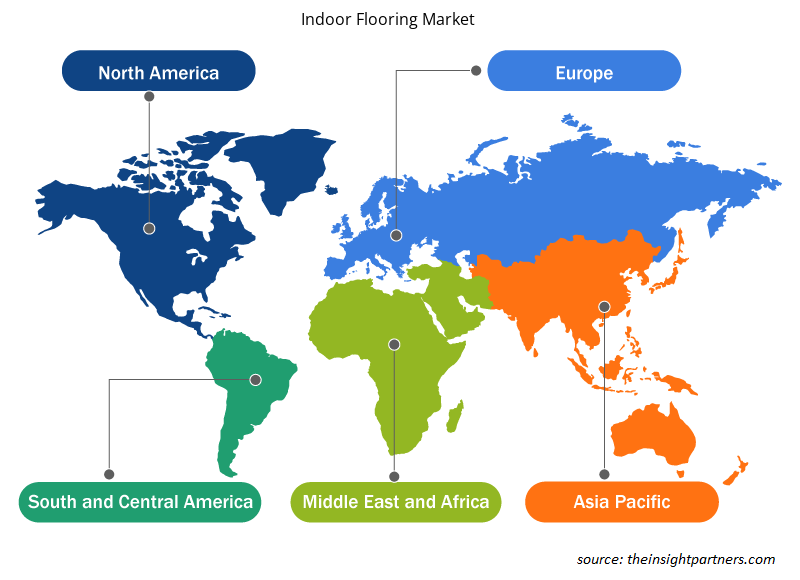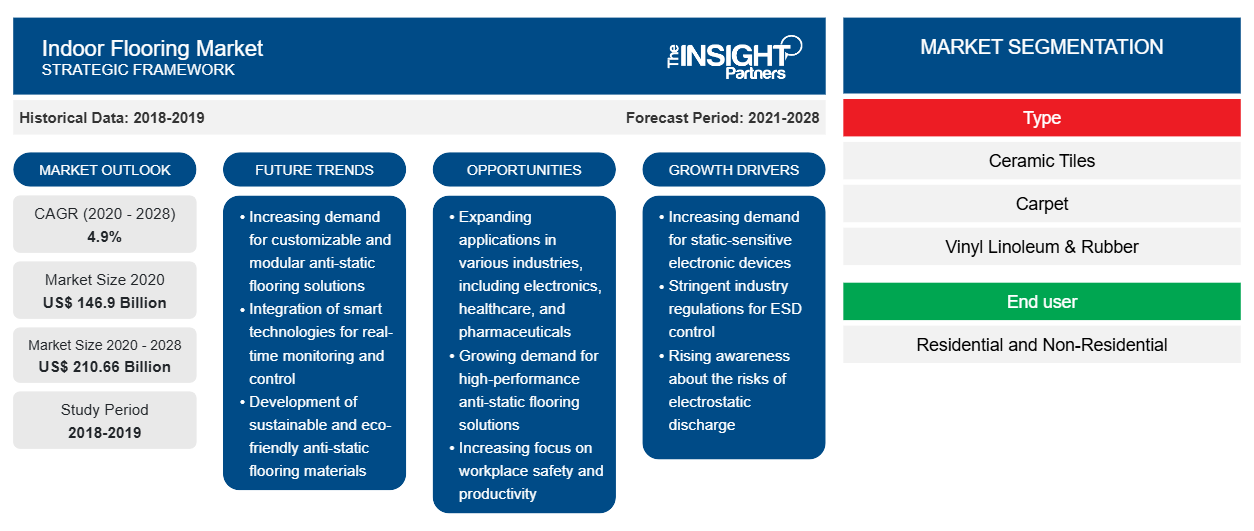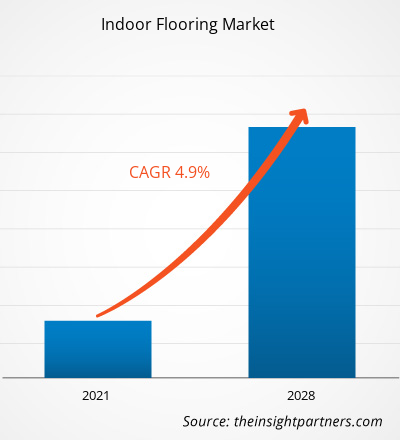[Forschungsbericht] Der Markt für Bodenbeläge für Innenräume wurde im Jahr 2020 auf 146,90 Milliarden US-Dollar geschätzt und wird im Prognosezeitraum von 2021 bis 2028 voraussichtlich mit einer durchschnittlichen jährlichen Wachstumsrate von 4,9 % wachsen.
In industriellen Umgebungen wie Lagerhallen, Flugzeughangars, Montagewerken, Lackierereien, Karosseriewerkstätten und Vertriebsanlagen sind Betonböden durch den Kontakt mit aggressiven und ätzenden Chemikalien und Ölen Verschleiß ausgesetzt; sie können auch durch Kratzer und Abrieb durch schwere Maschinen und Geräte wie Flugzeuge und Gabelstapler beschädigt werden.
Die rasche Industrialisierung und der Aufbau von Fertigungs- und Verarbeitungsanlagen in den Entwicklungsländern im asiatisch-pazifischen Raum treibt die Nachfrage nach Bodenbeschichtungen an, und die Pharma-, Lebensmittel- und Getränke- sowie die Automobilindustrie sind die wichtigsten Nachfragegeneratoren. Multinationale Konzerne in Europa und Amerika weiten ihre Aktivitäten in Entwicklungsländern des asiatisch-pazifischen Raums wie China und Indien aus. Da renommierte Hersteller ihre Betriebsstätten in den Ländern dieser Region errichten, steigt auch die Nachfrage nach Bodenbeschichtungen in Industriequalität. Der Anstieg der Nachfrage hat die Hersteller von Bodenbelägen für Innenräume dazu ermutigt, fortschrittliche und generische Produkte einzuführen und so den Markt für Bodenbeläge für Innenräume anzukurbeln.
Passen Sie diesen Bericht Ihren Anforderungen an
Sie erhalten kostenlos individuelle Anpassungen an jedem Bericht, einschließlich Teilen dieses Berichts oder einer Analyse auf Länderebene, eines Excel-Datenpakets sowie tolle Angebote und Rabatte für Start-ups und Universitäten.
- Holen Sie sich die wichtigsten Markttrends aus diesem Bericht.Dieses KOSTENLOSE Beispiel umfasst eine Datenanalyse von Markttrends bis hin zu Schätzungen und Prognosen.
Auswirkungen der COVID-19-Pandemie auf den Markt für Innenböden
Der COVID-19-Ausbruch hat die Infrastrukturentwicklung und die Weltwirtschaft erheblich beeinträchtigt. Die internationale Reaktion auf die rasche Störung wichtiger Infrastruktursektoren und -industrien ist im Gange. Laut dem jüngsten Lagebericht der Weltgesundheitsorganisation gehören die USA, Indien, Brasilien, Russland, Großbritannien, Frankreich, Spanien und Italien zu den am stärksten vom COVID-19-Ausbruch betroffenen Ländern. Der Ausbruch begann im Dezember 2019 in Wuhan (China) und hat sich seitdem über den ganzen Globus ausgebreitet. Die COVID-19-Krise hat die Industrien weltweit betroffen. Die Weltwirtschaft wurde im Jahr 2020 negativ beeinflusst, was sich voraussichtlich auch im Jahr 2021 fortsetzen wird. Die Pandemie hat Unternehmen und Lieferanten von Bodenbelägen für Innenräume auf der ganzen Welt in Schwierigkeiten gebracht. Die Marktteilnehmer erlebten Störungen in ihren Betriebsabläufen und werden voraussichtlich bis Mitte 2021 mit den Folgen zu kämpfen haben. Die Fabrikschließungen, Handelsverbote und Grenzschließungen haben sich negativ auf die Branche der Bodenbeläge für Innenräume ausgewirkt. Auf der anderen Seite öffnet sich der Markt im Jahr 2021, sodass erwartet wird, dass er in naher Zukunft an Fahrt gewinnt.
Einblicke in den Markt für Innenbodenbeläge
Zunehmender Einsatz von Bodenbeschichtungen in Sportanlagen
Bodenbeschichtungssysteme für Sporthallen und -plätze im Freien müssen die richtige Kombination von Eigenschaften aufweisen, wie z. B. hervorragende Punktelastizität, Rutschfestigkeit, Oberflächenelastizität und Rückfederung. Sie sollten außerdem extrem haltbar sein und gleichzeitig hervorragende optische Eigenschaften und Kompatibilität mit häufig verwendeten Farbstoffen und Zusatzstoffen aufweisen. Hochleistungsfähige Polyurethan-Bodenbeschichtungen verleihen Oberflächen hervorragende Elastizität und guten Halt und ermöglichen den Spielern gleichzeitig Agilität und geschickte Bewegungen auf dem Platz. Daher sind sie ein bevorzugtes Material für Bodenbeschichtungen in Sporthallen, Tennis-, Volleyball- und Basketballplätzen sowie Wrestling- und Turnhallen. Die steigenden Ausgaben von Regierungen und privaten Bauunternehmen für den Bau von Sportkomplexen und -hallen haben zur Entwicklung zahlreicher Sportanlagen in städtischen und vorstädtischen Gebieten geführt, die in den kommenden Jahren wahrscheinlich eine hohe Nachfrage nach speziellen Hochleistungs-Bodenbelägen für den Innenbereich erzeugen werden.
Typbasierte Markteinblicke
Der Markt für Bodenbeläge für Innenräume wird nach Typ in Keramikfliesen, Teppich, Vinyl-Linoleum und Gummi, Holz und Laminat und andere unterteilt. Das Segment Keramikfliesen dominiert den Markt für Bodenbeläge für Innenräume. Keramikfliesen werden häufig verwendet, um die Böden von Häusern, Krankenhauszimmern und Toiletten zu verschönern. Sie sind auf dem Markt in großer Menge erhältlich. Keramik ist auch als Porzellan bekannt. Keramikfliesen werden auch für Fußböden und Wände verwendet. Sie sind in einer breiten Palette von Varianten basierend auf Texturen, Mustern und Größen erhältlich. Auf den globalen und lokalen Märkten bieten viele Akteure verschiedene Arten verwandter Produkte an.
Die Akteure auf dem Markt für Innenböden konzentrieren sich auf Strategien wie Fusionen, Übernahmen und Marktinitiativen, um ihre Positionen auf dem Markt zu behaupten. Nachfolgend sind einige Entwicklungen der wichtigsten Akteure aufgeführt:
- Laut staatlichen und lokalen Wirtschaftsentwicklungsquellen investierte die Shaw Industries Group im Jahr 2020 20 Millionen US-Dollar in den Bau neuer Räumlichkeiten in Ringgold. Das Unternehmen plant, die neuen Räumlichkeiten in Ringgold am oder um den 1. Juni 2021 zu beziehen.
- Im Jahr 2018 erweitert Interface seine Reichweite im Bereich Performance Flooring durch die Übernahme einer Rubber Flooring Company
Regionale Einblicke in den Markt für Innenbodenbeläge
Die regionalen Trends und Faktoren, die den Markt für Innenböden im Prognosezeitraum beeinflussen, wurden von den Analysten von Insight Partners ausführlich erläutert. In diesem Abschnitt werden auch Marktsegmente und Geografie für Innenböden in Nordamerika, Europa, im asiatisch-pazifischen Raum, im Nahen Osten und Afrika sowie in Süd- und Mittelamerika erörtert.

- Erhalten Sie regionale Daten zum Markt für Innenbodenbeläge
Umfang des Marktberichts für Innenböden
| Berichtsattribut | Details |
|---|---|
| Marktgröße im Jahr 2020 | 146,9 Milliarden US-Dollar |
| Marktgröße bis 2028 | 210,66 Milliarden US-Dollar |
| Globale CAGR (2020 - 2028) | 4,9 % |
| Historische Daten | 2018-2019 |
| Prognosezeitraum | 2021-2028 |
| Abgedeckte Segmente | Nach Typ
|
| Abgedeckte Regionen und Länder | Nordamerika
|
| Marktführer und wichtige Unternehmensprofile |
|
Marktdichte von Bodenbelägen für Innenräume: Auswirkungen auf die Geschäftsdynamik verstehen
Der Markt für Bodenbeläge für Innenräume wächst rasant. Dies wird durch die steigende Nachfrage der Endverbraucher aufgrund von Faktoren wie sich entwickelnden Verbraucherpräferenzen, technologischen Fortschritten und einem größeren Bewusstsein für die Vorteile des Produkts vorangetrieben. Mit der steigenden Nachfrage erweitern Unternehmen ihr Angebot, entwickeln Innovationen, um die Bedürfnisse der Verbraucher zu erfüllen, und nutzen neue Trends, was das Marktwachstum weiter ankurbelt.
Die Marktteilnehmerdichte bezieht sich auf die Verteilung von Firmen oder Unternehmen, die in einem bestimmten Markt oder einer bestimmten Branche tätig sind. Sie gibt an, wie viele Wettbewerber (Marktteilnehmer) in einem bestimmten Marktraum im Verhältnis zu seiner Größe oder seinem gesamten Marktwert präsent sind.
Die wichtigsten auf dem Markt für Innenbodenbeläge tätigen Unternehmen sind:
- Forbo International SA
- Mats Inc.
- Tarkett
- Armstrong Flooring, Inc.
- Beaulieu International Gruppe
Haftungsausschluss : Die oben aufgeführten Unternehmen sind nicht in einer bestimmten Reihenfolge aufgeführt.

- Überblick über die wichtigsten Akteure auf dem Markt für Innenbodenbeläge
Der globale Markt für Bodenbeläge im Innenbereich ist wie folgt segmentiert:
Globaler Markt für Innenböden – nach Typ
- Keramikfliesen
- Teppich
- Vinyl Linoleum & Gummi
- Holz und Laminat
- Sonstiges
Globaler Markt für Innenböden – nach Endverbraucher
- Wohnen
- Nicht-Wohngebäude
Globaler Markt für Innenböden – nach Geografie
- Nordamerika
- UNS
- Kanada
- Mexiko
- Europa
- Frankreich
- Deutschland
- Italien
- Russland
- Vereinigtes Königreich
- Restliches Europa
- Asien-Pazifik (APAC)
- China
- Indien
- Japan
- Australien
- Südkorea
- Restlicher Asien-Pazifik-Raum
- Naher Osten und Afrika (MEA)
- Saudi-Arabien
- Vereinigte Arabische Emirate
- Südafrika
- Rest von MEA
- Süd- und Mittelamerika (SCAM)
- Brasilien
- Argentinien
- Rest von SCAM
Firmenprofile
- Forbo International SA
- Mats Inc.
- Tarkett
- Armstrong Flooring, Inc.
- Beaulieu International Gruppe
- Ecore International
- Schnittstelle, Inc.
- Toli Corporation
- Mohawk Industries, Inc.
- Shaw Industries Group, Inc.
- Historische Analyse (2 Jahre), Basisjahr, Prognose (7 Jahre) mit CAGR
- PEST- und SWOT-Analyse
- Marktgröße Wert/Volumen – Global, Regional, Land
- Branche und Wettbewerbsumfeld
- Excel-Datensatz



Report Coverage
Revenue forecast, Company Analysis, Industry landscape, Growth factors, and Trends

Segment Covered
This text is related
to segments covered.

Regional Scope
North America, Europe, Asia Pacific, Middle East & Africa, South & Central America

Country Scope
This text is related
to country scope.
Häufig gestellte Fragen
The indoor flooring market is led by ceramic tiles segment with highest share and is expected to dominate in the forecast period. The ceramic tiles are widely used to enhance the floors of houses, hospital rooms, toilets, and others. It is extensively available in the market. It is also known as porcelain. The ceramic tiles are used for flooring and walls. It is available in a broad range of varieties based on textures, patterns, and sizes. In the global and the local markets, many players offer different types of related products
Rise in number of commercial and residential construction projects. Moreover, surge in product innovations and launches, thereby substantially driving the automated guided vehicles (AGV) market.
Floors coating systems used in indoor and outdoor sports arenas need the right combination of properties such as excellent point elasticity, skid resistance, surface elasticity, and rebound properties. They should also be extremely durable, while displaying excellent optical characteristics and compatibility with commonly used coloring materials and additives. High-performance polyurethane floor coatings impart excellent elasticity and good grip to surfaces while allowing players to be agile and move skillfully on the court, which makes it a preferred material for coating floors in indoor sports halls; tennis, volleyball, and basketball courts; and wrestling and gymnastic halls. The rising expenditure by government and private construction companies in building sports complexes and arenas has led to the development of numerous sports facilities in urban as well as suburban areas, which are likely to generate a high demand for specialized high-performance indoor flooring materials in the coming years.
Trends and growth analysis reports related to Manufacturing and Construction : READ MORE..
The List of Companies - Indoor Flooring Market
- Forbo International SA
- Mats Inc.
- Tarkett
- Armstrong Flooring, Inc.
- Beaulieu International Group
- Ecore International
- Interface, Inc.
- Toli Corporation
- Mohawk Industries, Inc.
- Shaw Industries Group, Inc.
The Insight Partners performs research in 4 major stages: Data Collection & Secondary Research, Primary Research, Data Analysis and Data Triangulation & Final Review.
- Data Collection and Secondary Research:
As a market research and consulting firm operating from a decade, we have published and advised several client across the globe. First step for any study will start with an assessment of currently available data and insights from existing reports. Further, historical and current market information is collected from Investor Presentations, Annual Reports, SEC Filings, etc., and other information related to company’s performance and market positioning are gathered from Paid Databases (Factiva, Hoovers, and Reuters) and various other publications available in public domain.
Several associations trade associates, technical forums, institutes, societies and organization are accessed to gain technical as well as market related insights through their publications such as research papers, blogs and press releases related to the studies are referred to get cues about the market. Further, white papers, journals, magazines, and other news articles published in last 3 years are scrutinized and analyzed to understand the current market trends.
- Primary Research:
The primarily interview analysis comprise of data obtained from industry participants interview and answers to survey questions gathered by in-house primary team.
For primary research, interviews are conducted with industry experts/CEOs/Marketing Managers/VPs/Subject Matter Experts from both demand and supply side to get a 360-degree view of the market. The primary team conducts several interviews based on the complexity of the markets to understand the various market trends and dynamics which makes research more credible and precise.
A typical research interview fulfils the following functions:
- Provides first-hand information on the market size, market trends, growth trends, competitive landscape, and outlook
- Validates and strengthens in-house secondary research findings
- Develops the analysis team’s expertise and market understanding
Primary research involves email interactions and telephone interviews for each market, category, segment, and sub-segment across geographies. The participants who typically take part in such a process include, but are not limited to:
- Industry participants: VPs, business development managers, market intelligence managers and national sales managers
- Outside experts: Valuation experts, research analysts and key opinion leaders specializing in the electronics and semiconductor industry.
Below is the breakup of our primary respondents by company, designation, and region:

Once we receive the confirmation from primary research sources or primary respondents, we finalize the base year market estimation and forecast the data as per the macroeconomic and microeconomic factors assessed during data collection.
- Data Analysis:
Once data is validated through both secondary as well as primary respondents, we finalize the market estimations by hypothesis formulation and factor analysis at regional and country level.
- Macro-Economic Factor Analysis:
We analyse macroeconomic indicators such the gross domestic product (GDP), increase in the demand for goods and services across industries, technological advancement, regional economic growth, governmental policies, the influence of COVID-19, PEST analysis, and other aspects. This analysis aids in setting benchmarks for various nations/regions and approximating market splits. Additionally, the general trend of the aforementioned components aid in determining the market's development possibilities.
- Country Level Data:
Various factors that are especially aligned to the country are taken into account to determine the market size for a certain area and country, including the presence of vendors, such as headquarters and offices, the country's GDP, demand patterns, and industry growth. To comprehend the market dynamics for the nation, a number of growth variables, inhibitors, application areas, and current market trends are researched. The aforementioned elements aid in determining the country's overall market's growth potential.
- Company Profile:
The “Table of Contents” is formulated by listing and analyzing more than 25 - 30 companies operating in the market ecosystem across geographies. However, we profile only 10 companies as a standard practice in our syndicate reports. These 10 companies comprise leading, emerging, and regional players. Nonetheless, our analysis is not restricted to the 10 listed companies, we also analyze other companies present in the market to develop a holistic view and understand the prevailing trends. The “Company Profiles” section in the report covers key facts, business description, products & services, financial information, SWOT analysis, and key developments. The financial information presented is extracted from the annual reports and official documents of the publicly listed companies. Upon collecting the information for the sections of respective companies, we verify them via various primary sources and then compile the data in respective company profiles. The company level information helps us in deriving the base number as well as in forecasting the market size.
- Developing Base Number:
Aggregation of sales statistics (2020-2022) and macro-economic factor, and other secondary and primary research insights are utilized to arrive at base number and related market shares for 2022. The data gaps are identified in this step and relevant market data is analyzed, collected from paid primary interviews or databases. On finalizing the base year market size, forecasts are developed on the basis of macro-economic, industry and market growth factors and company level analysis.
- Data Triangulation and Final Review:
The market findings and base year market size calculations are validated from supply as well as demand side. Demand side validations are based on macro-economic factor analysis and benchmarks for respective regions and countries. In case of supply side validations, revenues of major companies are estimated (in case not available) based on industry benchmark, approximate number of employees, product portfolio, and primary interviews revenues are gathered. Further revenue from target product/service segment is assessed to avoid overshooting of market statistics. In case of heavy deviations between supply and demand side values, all thes steps are repeated to achieve synchronization.
We follow an iterative model, wherein we share our research findings with Subject Matter Experts (SME’s) and Key Opinion Leaders (KOLs) until consensus view of the market is not formulated – this model negates any drastic deviation in the opinions of experts. Only validated and universally acceptable research findings are quoted in our reports.
We have important check points that we use to validate our research findings – which we call – data triangulation, where we validate the information, we generate from secondary sources with primary interviews and then we re-validate with our internal data bases and Subject matter experts. This comprehensive model enables us to deliver high quality, reliable data in shortest possible time.


 Holen Sie sich ein kostenloses Muster für diesen Bericht
Holen Sie sich ein kostenloses Muster für diesen Bericht